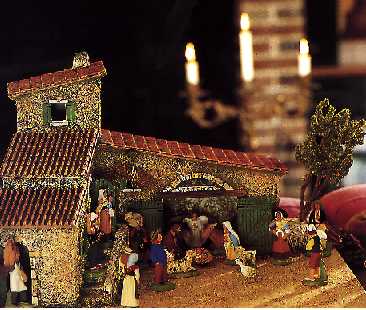
~ How
do you say Merry Christmas in France ? "Joyeux
Noël" ~
|
Provence
is an southern area
of France. Symbolically rich, charged with excitement
and emotion, Christmas traditions in Provence bring
another dimension of meaning and colour to the festivities.
It all really begins on
4th December, St. Barbe's Day. This is the start
of the "calendale" or
Christmastide period which continues right through
to Candlemas Day on 2nd February. Between these
two dates a series of traditions, festivities,
rituals
and customs are observed to a varying extent,
depending on the villages, depending on the family .
On the 4th December, wheat
germ must be planted in three saucers covered with
damp cotton wool. (Small packets of wheat germs are
sold in almost all bakery shops and the proceeds
go to charity). If the stalks grow straight and green,
the coming year will be prosperous. These miniature
wheat fields will afterwards be placed in the family
crib.
|
 |
To prepare
the Christmas crib, there are numerous santons markets
organised throughout the
Provence region from mid-November on. The real santon,
deriving from the Provençal word "santoun" meaning
little saint, is handmade from clay by craftsmen with
a love of their art. Santons must then take on a human
aspect, with a personalised appearance, character and
even social status.
They represent the inhabitants
of the village visiting the Christmas crib: pétanque players, fishmongers,
doctors, bakers, shepherds, etc. Here the traditional
crib is in fact an ideal model of a Provençal
village and its inhabitants. This tradition is present
in each department of Provence but it is particularly
strong in the Bouches du Rhône.
Throughout the month of December,
each town has its own Christmas market, giving everyone
the opportunity to prepare for Christmas in the most
pleasant way. Gastronomy, arts and crafts, decorations
and gift ideas are displayed in a warm friendly atmosphere.
The open-air markets often provide the occasion to
drink mulled winewith cinnamon to warm you up. You
can find all you need to prepare the traditional Christmas
meal, whether you prefer a Provençal meal or
not: Turkeys and foie gras rub shoulders with dishes
for the Provençal "great supper" and
the traditional 13 desserts.
The "great supper" is eaten on Christmas
Eve, before going to midnight mass. Everything is minutely
prepared. Each dish has its own symbolism and numbers
are important :
The table has 3 white
tablecloths - 3 for the 3 members of the Trinity – with 3 white lighted candelabras
and 3 saucers of sprouted wheat germs planted on St.
Barbe's Day. Absolutely no mistletoe believed to bring
bad luck&!
The "great supper" is
paradoxically made up of 7 lean dishes in memory
of the 7 sufferings of
Mary. It is served with 13 bread rolls followed by
the 13 desserts, which represent the Last Supper with
Jesus and the 12 apostles.
These lean dishes differ from one part of Provence
to another. The dishes often served are chard stalks
and celery, cauliflower, spinach and cod, omelette,
snails, garlic soup & but never any meat, simply
fish, shellfish, gratins, vegetables, soups and anchoïade
(anchovy paste). The only abundance is that of the
thirteen desserts.
|

The
thirteen desserts are eaten after Midnight mass.
They will remain on the table for the following 3
days, until 27th December:
- the 4 mendicant (orders): dry figs (Franciscans), almonds (Carmelites),
raisins (Dominicans) and hazelnuts (Augustinians),
- dates:
symbol of Christ who came from the Orient,
- nougat
(black and white) for the white penitents and black
penitents according to some people, while for others
white nougat, soft and creamy represents purity and
goodness, the harder and brittle black nougat symbolising
impurity and forces of evil&
- the "fougasse à l'huile
d'olive", also called "la pompe":
a flat loaf made using olive oil,
- quince
cheese or crystallised fruit in the Apt or Carpentras
regions,
- "oreillettes":
light thin waffles,
- fresh
fruit: mandarin oranges, oranges, pears, raisins
and winter melons preserved for the occasion.
|

Everywhere
you go you will hear Provençal Christmas carols
and to celebrate this sacred event some will be accompanied
by flute and tambourine players. In some villages,
the mass may be in Provençal. Mass can include
a living crib where the crib characters are represented
by inhabitants of the village dressed as: the Holy
Family (Jesus, Mary and Joseph), the three Wise Kings
and the shepherds.
In some villages you will also be able to attend the
ritual of the "Pastrage" ceremony
during midnight mass: a new-born lamb is brought as an offering (it is alive
and is not harmed in any way) either in a decorated cart, lined with straw and
leaves or carried by shepherds who have come to the church in a procession after
walking over the hills. Some midnight masses that include the "pastrages" ceremony
are very well known and attract a lot of people, in particular at Allauch, St
Rémy de Provence, Tarascon and St Michel de Frigolet, Barbentane, Fontvieille,
Rognonas.
The mass
can be accompanied by a "pastorale":
this is a theatrical representation of the Nativity,
sung and spoken in Provençal by people dressed
in Provençal costumes. The most widely known "Pastorale" is
the Maurel Pastorale but there are 250 different versions
based on village histories and Christmas traditions.
These traditions
are handed down from one generation to the next and
are part of the community's heritage: the "pastorales",
the "calandale" vigils with the great supper
and the thirteen desserts are organised in groups,
at the mill, or at the community centre, or even at
the church &, sometimes before 24th December so
everybody can celebrate Christmas with their family
in the conventional sense as everywhere else in France
with foie gras, turkey with chestnut stuffing and of
course Christmas sweetmeats. |

|
|